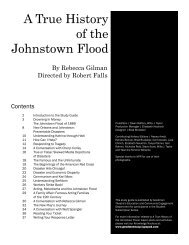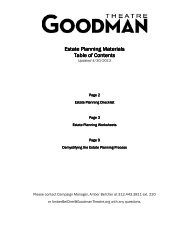El Nogalar Study Guide (9MB) - Goodman Theatre
El Nogalar Study Guide (9MB) - Goodman Theatre
El Nogalar Study Guide (9MB) - Goodman Theatre
Create successful ePaper yourself
Turn your PDF publications into a flip-book with our unique Google optimized e-Paper software.
Tales of Two Cities<br />
BY LIZ DENGEL<br />
Where two countries meet geographically, their cultures,<br />
politics and social dynamics also clash and meld.<br />
This process gives border regions a unique identity.<br />
The borderlands between Mexico and the U.S. are no<br />
exception.<br />
The border itself is simultaneously arbitrary and<br />
absolute. When the Treaty of Hidalgo established the<br />
modern U.S.-Mexico border in 1848, the Rio Grande<br />
became the dividing line between the two countries. At<br />
the time, the Rio Grande flowed through the middle of<br />
a Mexican province called Nuevo Santander. According<br />
to Dr. Américo Paredes, “Friends and relatives who had<br />
been near neighbors—within shouting distance across a<br />
few hundred feet of water—now were legally in different<br />
countries. If they wanted to visit each other, the law<br />
required that they travel many miles up- or downstream,<br />
to the nearest official crossing place, instead of<br />
swimming or boating directly across as they used to do<br />
before” (Paredes 26).<br />
Today, the borderline that must have puzzled the people<br />
of Nuevo Santander carries great significance for both<br />
residents of Mexico and the U.S. On the U.S. side of the<br />
border, per-capita income is more than $30,000. On<br />
the Mexican side, it is less than $4,000. Spread out<br />
along the 2,000-mile border, there are 42 ports by which<br />
people can pass legally between the two countries. A<br />
fence measuring 700 miles long, called “The Great Wall<br />
of Mexico” by U.S. Homeland Security, reinforces the<br />
border. Along the border between Mexico and the U.S.<br />
are dozens of twin port cities. Despite their regional<br />
similarities, close proximity and frequent intermingling,<br />
these pairs present different economic, social and<br />
political realities. Such twin cities allow us to glimpse the<br />
difference that a border makes.<br />
The towns of Nogales, Ariz., left, and Nogales, Mexico, right, stand separated by a high concrete and steel fence. Enough illegal crossings occur<br />
here to warrant 24-hour Border Patrol operations. Photo Courtesy of Sgt. 1st Class Gordon Hyde.<br />
24<br />
<strong>El</strong><strong>Nogalar</strong>.indd 24<br />
3/25/2011 4:05:40 PM
















